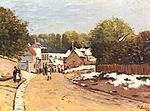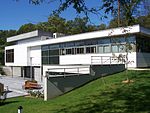Château Louis XIV

The Château Louis XIV is a château constructed between 2008 and 2011 in the commune of Louveciennes in the Yvelines department in the Île-de-France region.The chateau was built by the property developer Emad Khashoggi's property development company COGEMAD using traditional craftsmanship techniques and materials. Located between Versailles and Marly-le-Roi on a 23-hectare (57-acre) walled site, the property is surrounded by moats and has a constructed surface area of 7,000 m2 (75,350 ft2), 5,000 m2 (53,800 ft2) of which are living space. The property pays various tributes to Louis XIV of France, France's Sun King and stands on land which once formed part of the Versailles estate.Khashoggi had previously restored the Palais Rose in Le Vésinet and the Château du Verduron in Marly-le-Roi. The Chateau Louis XIV was built on the site of the former Chateau du Camp in Louveciennes, with the aim of building a modern house, with hi-tech controls incorporated within a 17th-century aspect, layout, and materials. The château incorporates elements inspired by the château Vaux-le-Vicomte and the Palace of Versailles.In 2015, the chateau was purchased by Saudi Crown Prince Mohammad bin Salman for US$301 million, a world record for a residential property.
Excerpt from the Wikipedia article Château Louis XIV (License: CC BY-SA 3.0, Authors, Images).Château Louis XIV
Chemin des Gressets, Saint-Germain-en-Laye
Geographical coordinates (GPS) Address External links Nearby Places Show on map
Geographical coordinates (GPS)
| Latitude | Longitude |
|---|---|
| N 48.8499 ° | E 2.1204 ° |
Address
Château Louis XIV
Chemin des Gressets
78430 Saint-Germain-en-Laye
Ile-de-France, France
Open on Google Maps










